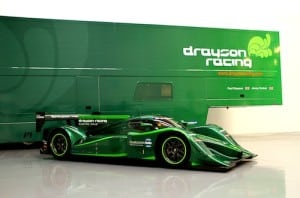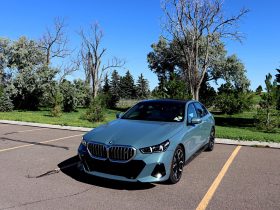
After testing Qualcomm Halo’s electric vehicle wireless charging system, Drayson Racing Technologies finalizes the agreement. A new era of continuous charging as a new electric car race has just begun.
The idea of charging while you drive is appealing and a few wireless charging companies have been hard at work. EVAtran, Bosch and Qualcomm, to name a few have been prominent. Qualcomm Halo’s system has a unique advantage that removes nagging misalignment problems with traditional systems. It uses three coils on the ground and one on the vehicle, which greatly reduces any need for aligning the coil funnels. See our previous article on; Drayson Racing Technologies aims for another electric land speed world record.
Drayson Racing Technologies, the electric modified Lola B19 spearheaded by Paul Drayson, UK ex-finance minister has been an early adopter, whom we met and interviewed last year at EVS26. After breaking a few world speed records with the green electric Lola, Drayson Racing Technologies has entered into a wireless electric vehicle charging (WEVC) license agreement with Qualcomm Incorporated to include Qualcomm Halo WEVC technology in its products.
Why Is It Important?
The importance to continuously charge while driving is tremendous. The electric car, (EV) industry is still maturing and the current generations offer a range of 100 miles at best. While this might be perceived as insufficient for some, it does more then answer 80% of our daily driving needs of 40 miles in the US. Still, the appeal to continuously charge while traveling opens the door to long distance electric car trips.
Different Approaches, Same Results.
Car manufacturers are tackling the perceived limited range of electric cars differently. Fast charging systems allow an 80% charge in as little as 20 minutes. Tesla’s luxurious Model S offers 160 in its basic configuration and 300 in its top offering. If that isn’t enough for you, the company is working on swapping the battery pack for a fresh one under in 90 seconds. Traditional car makers put enough battery capacity to get as close as possible to the magical 100 mile range.
If swapping or packing everything onboard is the preferred way, imagine what charging as you go offers? Imagine stretches of highways with coils every 60 miles, recharging your electric car batteries as you go. You could feasibly drive from New York to Los Angeles, or Alaska to Florida.
Race Applications.
What concerns us most here are the race applications. With the upcoming Formula E and the dilemma its producers face bringing a new generation of spectators onboard means the electric race cars have to deliver long distance performance. By putting coils over parts of a race track, the electric racers could extend their range.
This is overall great news and shows the world of battery operated cars is outpacing any other modes of transportation. In a very short four years, we went from 60 miles range EVs to now about 100, 160 and even 300 miles. Wireless charging as you drive will only extend the pleasure of driving these torquey cars long distance. Congratulations Drayson Racing Technologies and Qualcomm Halo.











